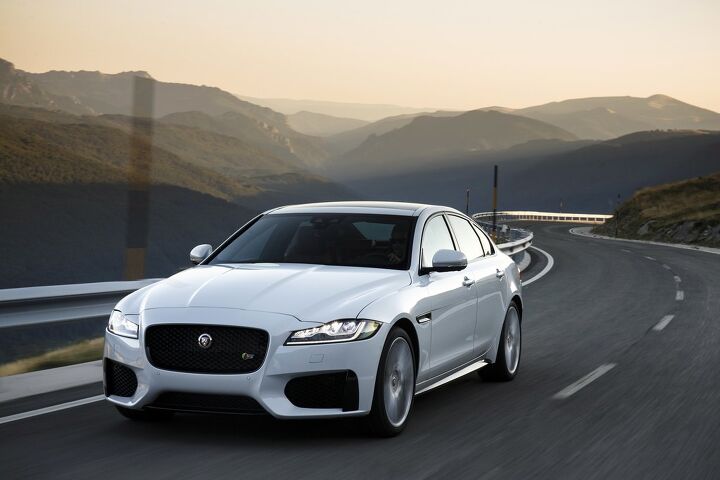High-output 2.0-liter Engine Joins 2018 Jaguar Lineup

The engineers at Jaguar have crafted a new engine for the automaker, essentially filling in the last power gap in the brand’s lineup. Carrying the Ingenium name and a 30t badge, the automaker’s latest in-house mill is a turbocharged 2.0-liter four-cylinder designed to fill the space between the automaker’s 2.0-liter turbodiesel and 3.0-liter supercharged V6.
What kind of power, speed and fuel economy will this bring to the 2018 XE, XF and F-Pace, you asl? Jaguar has provided us with the answers.
Generating 296 horsepower and 295 lb-ft of torque, the engine will be made available on uplevel trims of these three models. You’ll only find it paired with an eight-speed automatic transmission.
Engineers at Jaguar’s Wolverhampton, UK engine plant added twin-scroll turbos with ceramic ball bearings to cut down on friction and fitted a high flow compressor wheel to boost output. The automaker has always claimed its future engines would leave the oven smooth and efficient and, while we haven’t tested it yet, the figures are certainly competitive.
Compared to the entry-level 2.0-liter in Jag’s stable, the latest four-banger increases the pony count by 49 while delivering an extra 26 lb-ft of twist. In comparison, the diesel delivers 180 hp and 318 lb-ft and the V6 manages 340 hp and 332 lb-ft.
The EPA has yet to test 2018 models equipped with the new Ingenium, so we’re left with a manufacturer’s estimate for fuel economy. In the all-wheel-drive F-Pace, Jag claims the engine will return 21 miles per gallon in the city and 25 mpg in highway driving. A zero-to-60 mph sprint should wrap up in 5.7 seconds. Both the rear-drive XF and AWD XE, when equipped with the potent 2.0-liter, should see gas mileage of 23 mpg city and 28 mpg highway.
That’s the same city fuel economy as the entry-level RWD XF, and 2 mpg less on the highway.
When so equipped, Jaguar claims a rear-drive XF should reach 60 mph in 5.4 seconds, with the smaller XE hitting the mark in 5.2 seconds.
Besides the new engine, all three Jaguar models carry over into 2018 with little change in content. The automaker has added a gesture-controlled trunklid release to the two sedans, while all three see the addition of available Forward Vehicle Guidance and Forward Traffic Detection safety systems.
[Image: Jaguar Land Rover]

More by Steph Willems
Latest Car Reviews
Read moreLatest Product Reviews
Read moreRecent Comments
- Lichtronamo Watch as the non-us based automakers shift more production to Mexico in the future.
- 28-Cars-Later " Electrek recently dug around in Tesla’s online parts catalog and found that the windshield costs a whopping $1,900 to replace.To be fair, that’s around what a Mercedes S-Class or Rivian windshield costs, but the Tesla’s glass is unique because of its shape. It’s also worth noting that most insurance plans have glass replacement options that can make the repair a low- or zero-cost issue. "Now I understand why my insurance is so high despite no claims for years and about 7,500 annual miles between three cars.
- AMcA My theory is that that when the Big 3 gave away the store to the UAW in the last contract, there was a side deal in which the UAW promised to go after the non-organized transplant plants. Even the UAW understands that if the wage differential gets too high it's gonna kill the golden goose.
- MKizzy Why else does range matter? Because in the EV advocate's dream scenario of a post-ICE future, the average multi-car household will find itself with more EVs in their garages and driveways than places to plug them in or the capacity to charge then all at once without significant electrical upgrades. Unless each vehicle has enough range to allow for multiple days without plugging in, fighting over charging access in multi-EV households will be right up there with finances for causes of domestic strife.
- 28-Cars-Later WSJ blurb in Think or Swim:Workers at Volkswagen's Tennessee factory voted to join the United Auto Workers, marking a historic win for the 89- year-old union that is seeking to expand where it has struggled before, with foreign-owned factories in the South.The vote is a breakthrough for the UAW, whose membership has shrunk by about three-quarters since the 1970s, to less than 400,000 workers last year.UAW leaders have hitched their growth ambitions to organizing nonunion auto factories, many of which are in southern states where the Detroit-based labor group has failed several times and antiunion sentiment abounds."People are ready for change," said Kelcey Smith, 48, who has worked in the VW plant's paint shop for about a year, after leaving his job at an Amazon.com warehouse in town. "We look forward to making history and bringing change throughout the entire South." ...Start the clock on a Chattanooga shutdown.


































Comments
Join the conversation
Ford royally screwed up when they effectively forced Jaguar to. Oils the S type because an American consumer focus group said they liked it. Whilst some Americans did like it Jaguars home market positively hated it as Brits didn't want retro Jags. So Jaguar has had the embrace modernity which is no bad thing, however I'd like to see them spend more time on their interiors or at least just get Range Rover to design them.
With a torque number like that from a 2.0T, can you say "turbo lag"?